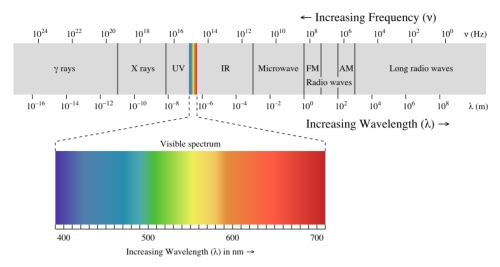Using your mobile phone, you can see infrared radiation – a normally invisible part of the electromagnetic spectrum. Ken’s Tech Tips looks at some of the physics of electromagnetic waves and explains how you can see this invisible world – and you don’t need anything more than the mobile phone in your pocket.
What is infrared radiation?
Infrared is a form of electromagnetic radiation. Other forms of electromagnetic radiation (EM radiation) include visible light, x-rays, microwaves (the EM waves that wi-fi networks use and also the waves that cook your food in microwave ovens) and radio waves. The difference between all these different forms of radiation are the wavelength of the EM wave. We can illustrate this electromagnetic spectrum (CC-licensed image from Wikipedia):

What is the difference between visible light and infrared?
Visible light and infrared are both forms of electromagnetic radiation but with different wavelengths. Visible light has a wavelength of between 400nm and 700nm (a nanometer is so small that we can fit 1,000,000,000 in just 1 meter). We can only “see” the EM radiation in this range. At 700nm and longer, we enter the realm of infrared radiation.
Why can mobile phone cameras “see” infrared?
Most cameras are designed to capture an image of what people can see. Hence a good camera would only detect EM radiation in the visible light spectrum (between 400nm and 700nm).
Yet the charged couple devices used within cameras are typically manufactured to pick up EM radiation between 300nm and 1100nm. This means they are capable of detecting infrared light too (between 700nm and 1100nm is infrared).
To improve image quality, camera manufacturers typically add films and filters to block out infrared light and ensure only visible light reaches the CCD. If the infrared radiation was recorded by the camera and appeared in our photos, the photos would not be an accurate representation of what we can see – i.e. what we want to photograph!
Mobile phone cameras tend to be produced a lot cheaper than proper digital cameras and hence the vast majority of mobile phone cameras have a much thinner film/filter to block out infrared light. The lack of infrared filter is one reason photographs taken on mobile phones don’t look as good as those taken on proper digital cameras but it also provides us with an opportunity to use our mobiles to “see” in infrared.
How can I harness this fact?
Simply point your mobile phone camera towards a infrared light source and you can begin to see this new invisible infrared world!
For example, stick your phone camera in front of a television remote control and start pressing some buttons: you’ll see a few flashes of light (your remote uses invisible IR radiation to communicate with your TV – you wouldn’t normally be able to see this radiation as our eyes are not sensitive to the infrared wavelengths used by the remote). If you’ve got a Nintendo Wii, point your phone camera at the sensor bar. You’ll notice the sensor bar emits invisible IR radiation (this is how the Wiimotes track your movement).
Unfortunately, you won’t see the world in true infrared. Your mobile phone camera is sensitive to visible light too – and fortunately (although unfortunately in our case) this always registers much brighter on the CCD and drowns out the infrared image. If you’re really serious about seeing the world in infrared, you can pick up an infrared filter from Amazon. These filters will block out visible light and hence allow you to get a better image of the invisible infrared world.
Michael Ford said:
I’m trying to figure out the spectrum differents between cell camera and eye sight. in viewing sun rises and sun sets. my camera can’t do justice to such pictures. though maybe my brain is perceiving a spectrum my camera can’t ?
Anthony said:
Thanks for the explanation.
Our pulse laser in the lab is 800nm. We had been using a specilaised IR viewer and cards that fluoresce around that wavelength. I took a picture of our setup with my phone and was pleased to see the laser would show on any surface as a violet colour.
Steve Harris MD said:
Infrared is not stopped by any of the dies that are used to print conventional films for projection. Therefore, you can make a pretty good infrared filter, by simply preparing a film projection “slideshow” using slides that have been unexposed, and are therefore black after development.
The trick is that you need a camera store where you can get them to mount 25 pieces of unexposed but developed cheap photographic film. You have to tell them to do it, or else they won’t, since they look black and worthless. Just buy the cheapest 35 mm film you can find, and handed over to be “developed.” Tell them that you want 25 totally black slides for projection. Those slides will be 25 infrared filters, and pretty good ones. You can use them on anything including over the lens of your normal video cameras. They also filter light sources very well especially one on top of another. Looking at one of these through an infrared camera will show you that it is black in the visible but completely transparent in the infrared. Lots of fun.
Rich replied:
Thanks very much for this. I have a use case for this and I happen to have 300 rolls of RDP III in my freezer!